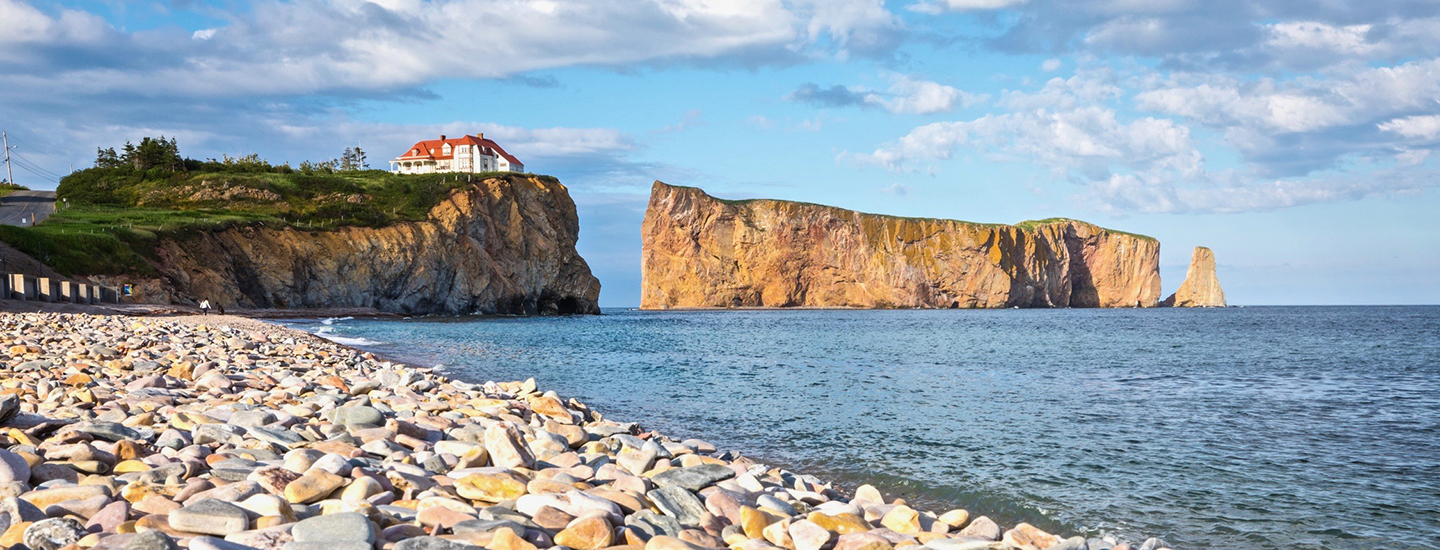


Whales and tales, birds and beers: The coastal towns of the Gaspésie loop are a breath of fresh air.
By Tim Johnson | May 05, 2021
Coming around the corner, my jaw drops. Yes, it’s a cliché, but that’s actually what happens—my mouth falls open at the first sighting of the famous Percé Rock. Familiar from photos I remember in my French class livre, that huge hunk of limestone still surprises, in size and grandeur. It’s the destination on this trip, but, to use another cliché, half the fun is getting here.
I’m on the far reaches of the Gaspésie, road-tripping from Ontario. A popular summer route for Québécois, especially Montrealers, the loop of provincial Route 132 traces the edges of the peninsula—mountains on one side, sea and river on the other, a new, charming village around every turn. It’s a drive best enjoyed slowly, with plenty of time built in for unexpected stops and little journeys of exploration down random side-roads.
“People worked and worked and didn’t stop until they died.”
From Rimouski, I head inland, winding through the rugged Chic-Choc Mountains and then making a left at Chaleur Bay. After a stop at the Carleton-sur-Mer Lighthouse, just across from New Brunswick, and the Atlantic Bubble, I roll into Banc-de-Pêche-de-Paspébiac Historic Site, where, starting in 1768 and carrying on for two centuries, fishermen brought in massive amounts of cod. As many as 2,000 workers dried the fish, packed it in salt and then sent it off across the globe. “People worked and worked and didn’t stop until they died,” a guide tells me, a sobering thought that I ponder at a picnic table afterward, dining not on cod, but on fresh lobster from the on-site restaurant.
From there, the road continues to unfold. Here, a last-minute turn to find a hidden beach. There, a ramble down a riverside boardwalk or a pint of locally brewed beer on a downtown patio. At Percé, I sit on my hotel-room balcony, sipping a glass of wine and watching the colour of the rock shift in the late-day sun.
Dive Buddy
Gannets catch fish at deeper depths than most diving birds. With a wingspan of up to two metres, they can dive from a height of 30 metres and can reach 100 kilometres per hour. when they hit the water.
The next morning, I take the ferry out to Bonaventure Island, where a warden and naturalist named Jacques meets me just beyond the dock. “We have as many as 200,000 birds here,” he explains, noting that one of the largest colonies of gannets in the world is located on this small island, a Quebec national park. I make the hike to see them, a five-and-a-half-kilometre round trip on the steady rise of the Colony Trail, at the end finding 60,000 mating pairs of white birds as far as the eye can see. Their white wings and backs cover the red soil all the way to the horizon, individual birds squawking and swooping low.
In every village, there’s excellent fromage and poutine and seafood. At Forillon National Park, I spend an afternoon on the water, taking a whale-watching tour to see humpbacks. In Gaspé town, I find rich nautical history at the Musée de la Gaspésie. After a turn into the mountains—which rise, green and sharp, through the centre of the peninsula—and a night in a cabin at Parc National de la Gaspésie, my last night is in a small hotel on the water in the town of Matane. Here, the St. Lawrence is so wide you can barely see the other side. Outside, a semicircle of chairs surrounds a big outdoor fireplace. Not yet weary from the road, I settle into one, listening to the fire crackle and the staccato Québécois chatter around me, staying put until the last streaks of pink fade to twilight, the gloaming of the sky melding seamlessly with the blue of this mighty river.
